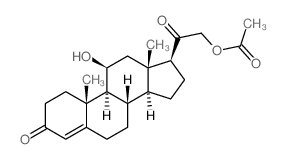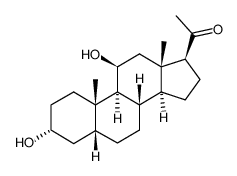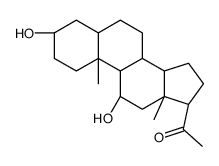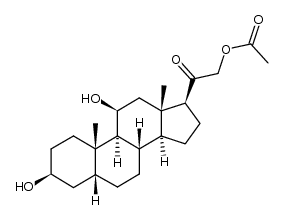Pregn-4-ene-3,20-dione,21-(acetyloxy)-11-hydroxy-, (11b)-

Pregn-4-ene-3,20-dione,21-(acetyloxy)-11-hydroxy-, (11b)- structure
|
Common Name | Pregn-4-ene-3,20-dione,21-(acetyloxy)-11-hydroxy-, (11b)- | ||
|---|---|---|---|---|
| CAS Number | 1173-26-8 | Molecular Weight | 388.49700 | |
| Density | 1.2g/cm3 | Boiling Point | 542.2ºC at 760 mmHg | |
| Molecular Formula | C23H32O5 | Melting Point | 151ºC | |
| MSDS | Chinese USA | Flash Point | 183.5ºC | |
| Symbol |

GHS07 |
Signal Word | Warning | |
| Name | Corticosterone 21-Acetate |
|---|---|
| Synonym | More Synonyms |
| Density | 1.2g/cm3 |
|---|---|
| Boiling Point | 542.2ºC at 760 mmHg |
| Melting Point | 151ºC |
| Molecular Formula | C23H32O5 |
| Molecular Weight | 388.49700 |
| Flash Point | 183.5ºC |
| Exact Mass | 388.22500 |
| PSA | 80.67000 |
| LogP | 3.23750 |
| Vapour Pressure | 5.14E-14mmHg at 25°C |
| Index of Refraction | 1.556 |
|
Section I.Chemical Product and Company Identification Chemical Name Corticosterone 21-Acetate Portland OR SynonymPregn-4-ene-3,20-dione, 21-(acetyloxy)-11- hydroxy-, (11-beta)- (9 CI) Chemical FormulaC23H32O5 CAS Number1173-26-8
Section II.Composition and Information on Ingredients Toxicology Data Chemical NameCAS Number Percent (%)TLV/PEL Corticosterone 21-AcetateMin. Not available.Not available. 1173-26-8 98.0(HPLC) Section III. Hazards Identification Acute Health EffectsNo specific information is available in our data base regarding the toxic effects of this material for humans. However, exposure to any chemical should be kept to a minimum. Skin and eye contact may result in irritation. May be harmful if inhaled or ingested. Always follow safe industrial hygiene practices and wear proper protective equipment when handling this compound. Follow safe industrial hygiene practices and always wear proper protective equipment when handling this compound. Chronic Health EffectsCARCINOGENIC EFFECTS : Not available. MUTAGENIC EFFECTS : Not available. TERATOGENIC EFFECTS : Not available. DEVELOPMENTAL TOXICITY: REPRODUCTIVE EFFECTS: Rat TDLo (intraperitoneal) 250mg/kg, female, 3 Days prior to mating. Toxic Effects: Maternal Effects- Ovaries, fallopian tubes. Maternal Effects- Uterus, cervix, vagina. Maternal Effects- Menstrual cycle changes or disorders. Rat TDLo (intraperitoneal) 250mg/kg, male, 1 Day prior to mating. Toxic Effects: Paternal Effects- Testes, epididymis, sperm duct. Mouse TDLo (subcutaneous) 7200mg/kg, female, 11-14 Days of pregnancy. Toxic Effects: Effects on Fertility- Post-implantation mortality. Effects on Embryo or Fetus- Fetotoxicity. Specific Developmental Abnormalities- Craniofacial. Repeated or prolonged exposure to this compound is not known to aggravate existing medical conditions. Section IV.First Aid Measures Eye ContactCheck for and remove any contact lenses. In case of contact, immediately flush eyes with plenty of water for at least 15 minutes. Get medical attention. Skin Contact In case of contact, immediately flush skin with plenty of water. Remove contaminated clothing and shoes. Wash clothing before reuse. Thoroughly clean shoes before reuse. Get medical attention. If the victim is not breathing, perform mouth-to-mouth resuscitation. Loosen tight clothing such as a collar, tie, belt or Inhalation waistband. If breathing is difficult, oxygen can be administered. Seek medical attention if respiration problems do not improve. IngestionINDUCE VOMITING by sticking finger in throat. Lower the head so that the vomit will not reenter the mouth and throat. Loosen tight clothing such as a collar, tie, belt or waistband. If the victim is not breathing, perform mouth-to-mouth resuscitation. Examine the lips and mouth to ascertain whether the tissues are damaged, a possible indication that the toxic material was ingested; the absence of such signs, however, is not conclusive. Continued on Next Page Corticosterone 21-Acetate Section V.Fire and Explosion Data Not available. FlammabilityMay be combustible at high temperature.Auto-Ignition Flash PointsFlammable Limits Not available.Not available. Combustion Products These products are toxic carbon oxides (CO, CO 2). Fire Hazards Not available. Explosion HazardsRisks of explosion of the product in presence of mechanical impact: Not available. Risks of explosion of the product in presence of static discharge: Not available. Fire Fighting Media SMALL FIRE: Use DRY chemical powder. LARGE FIRE: Use water spray, fog or foam. DO NOT use water jet. and Instructions Consult with local fire authorities before attempting large scale fire-fighting operations. Section VI.Accidental Release Measures Spill CleanupLight sensitive material. InstructionsUse a shovel to put the material into a convenient waste disposal container. Finish cleaning the spill by rinsing any contaminated surfaces with copious amounts of water. Consult federal, state, and/or local authorities for assistance on disposal. Section VII. Handling and Storage Handling and StorageLIGHT SENSITIVE. Keep away from heat. Mechanical exhaust required. When not in use, tightly seal the container and store in a dry, cool place. Avoid excessive heat and light. Do not breathe dust. Information Always store away from incompatible compounds such as oxidizing agents. Section VIII. Exposure Controls/Personal Protection Engineering ControlsUse process enclosures, local exhaust ventilation, or other engineering controls to keep airborne levels below recommended exposure limits. If user operations generate dust, fume or mist, use ventilation to keep exposure to airborne contaminants below the exposure limit. Personal ProtectionSplash goggles. Lab coat. Dust respirator. Boots. Gloves. Suggested protective clothing might not be sufficient; consult a specialist BEFORE handling this product. Be sure to use a MSHA/NIOSH approved respirator or equivalent. Exposure LimitsNot available. Section IX. Physical and Chemical Properties Solubility Physical state @ 20°CSolid. (White powder.)Not available. Not available. Specific Gravity Molecular Weight388.50Partition CoefficientNot available. Boiling Point Not available.Vapor PressureNot applicable. Melting Point145 to 146°C (293 to 294.8°F)Vapor DensityNot available. Refractive IndexNot available.VolatilityNot available. Critical TemperatureNot available.OdorNot available. ViscosityNot available.TasteNot available. Section X.Stability and Reactivity Data Stability This material is stable if stored under proper conditions. (See Section VII for instructions) Conditions of InstabilityLight sensitive. Avoid excessive heat and light. Incompatibilities Reactive with oxidizing agents. Continued on Next Page Corticosterone 21-Acetate Section XI. Toxicological Information RTECS NumberGM7820000 Routes of ExposureEye Contact. Ingestion. Inhalation. Toxicity DataNot available. CARCINOGENIC EFFECTS : Not available. Chronic Toxic Effects MUTAGENIC EFFECTS : Not available. TERATOGENIC EFFECTS : Not available. DEVELOPMENTAL TOXICITY: REPRODUCTIVE EFFECTS: Rat TDLo (intraperitoneal) 250mg/kg, female, 3 Days prior to mating. Toxic Effects: Maternal Effects- Ovaries, fallopian tubes. Maternal Effects- Uterus, cervix, vagina. Maternal Effects- Menstrual cycle changes or disorders. Rat TDLo (intraperitoneal) 250mg/kg, male, 1 Day prior to mating. Toxic Effects: Paternal Effects- Testes, epididymis, sperm duct. Mouse TDLo (subcutaneous) 7200mg/kg, female, 11-14 Days of pregnancy. Toxic Effects: Effects on Fertility- Post-implantation mortality. Effects on Embryo or Fetus- Fetotoxicity. Specific Developmental Abnormalities- Craniofacial. Repeated or prolonged exposure to this compound is not known to aggravate existing medical conditions. Acute Toxic EffectsNo specific information is available in our data base regarding the toxic effects of this material for humans. However, exposure to any chemical should be kept to a minimum. Skin and eye contact may result in irritation. May be harmful if inhaled or ingested. Always follow safe industrial hygiene practices and wear proper protective equipment when handling this compound. Follow safe industrial hygiene practices and always wear proper protective equipment when handling this compound. Section XII.Ecological Information EcotoxicityNot available. Environmental FateNot available. Section XIII. Disposal Considerations Waste DisposalRecycle to process, if possible. Consult your local regional authorities. You may be able to dissolve or mix material with a combustible solvent and burn in a chemical incinerator equipped with an afterburner and scrubber system. Observe all federal, state and local regulations when disposing of the substance. Section XIV. Transport Information DOT ClassificationNot a DOT controlled material (United States). PIN NumberNot applicable. Proper Shipping Name Not applicable. Packing Group (PG)Not applicable. DOT Pictograms Section XV. Other Regulatory Information and Pictograms TSCA Chemical InventoryThis product is NOT on the EPA Toxic Substances Control Act (TSCA) inventory. The following notices are required by 40 CFR 720.36 (C) for those products not on the inventory list: (EPA) (i) These products are supplied solely for use in research and development by or under the supervision of a technically qualified individual as defined in 40 CFR 720.0 et sec. (ii) The health risks of these products have not been fully determined. Any information that is or becomes available will be supplied on an MSDS sheet. WHMIS ClassificationNot available. (Canada) EINECS Number (EEC) 214-635-8 EEC Risk Statements Not available. Japanese Regulatory Data Not available. Continued on Next Page SECTION 16 - ADDITIONAL INFORMATION N/A |
CHEMICAL IDENTIFICATION
HEALTH HAZARD DATAACUTE TOXICITY DATA
|
|
~10% 
Pregn-4-ene-3,2... CAS#:1173-26-8 |
| Literature: Kraan, Gijsbert P. B.; Wee, Kees T. van; Wolthers, Bert G.; Molen, Jan C. van der; Nagel, Gijs T.; et al. Steroids, 1993 , vol. 58, # 10 p. 495 - 503 |
|
~% 
Pregn-4-ene-3,2... CAS#:1173-26-8 |
| Literature: Journal of the Chemical Society, , p. 517 |
|
~% 
Pregn-4-ene-3,2... CAS#:1173-26-8 |
| Literature: Helvetica Chimica Acta, , vol. 27, p. 1287,1292 |
|
~% 
Pregn-4-ene-3,2... CAS#:1173-26-8 |
| Literature: Helvetica Chimica Acta, , vol. 27, p. 1287,1292 |
|
~% 
Pregn-4-ene-3,2... CAS#:1173-26-8 |
| Literature: Helvetica Chimica Acta, , vol. 27, p. 1287,1292 |
|
~% 
Pregn-4-ene-3,2... CAS#:1173-26-8 |
| Literature: Helvetica Chimica Acta, , vol. 27, p. 1287,1292 |
|
~% 
Pregn-4-ene-3,2... CAS#:1173-26-8 |
| Literature: CH204233 , ; |
|
~% 
Pregn-4-ene-3,2... CAS#:1173-26-8 |
| Literature: Helvetica Chimica Acta, , vol. 27, p. 1287,1292 |
| Precursor 9 | |
|---|---|
| DownStream 2 | |
|
Ontogeny of gastric mucosal permeability responses to luminal H+ and bile salt in the rat.
Am. J. Physiol. 250(5 Pt 1) , G617-24, (1986) Gastric mucosal responses to intraluminal instillation of acid (10, 50, and 150 mM HCl) and acidified solutions of sodium taurocholate (10 mM) were measured in rats between 5 and 60 days after birth. ... |
|
|
Chronic administration of corticosterone impairs LH signal transduction and steroidogenesis in rat Leydig cells.
J. Steroid Biochem. Mol. Biol. 72(3-4) , 155-62, (2000) The mechanism involved in the inhibitory actions of chronic corticosterone treatment on Leydig cell steroidogenesis was studied in adult Wistar rats. Rats were treated with corticosterone-21-acetate (... |
|
|
Sensitivity to corticosterone-induced cleft palate is not associated with H-2.
Proc. Soc. Exp. Biol. Med. 176(1) , 14-21, (1984) The frequency of cleft palate (CP) and corticosterone levels in maternal plasma and amniotic fluid were determined in pregnant C57BL/10 (H-2b) and congenic B10.A (H-2a) mice after the ip injection of ... |
| 11β,21-Dihydroxy-4-pregnene-3,20-dione 21-Acetate |
| [2-[(8S,9S,10R,11S,13S,14S,17S)-11-hydroxy-10,13-dimethyl-3-oxo-1,2,6,7,8,9,11,12,14,15,16,17-dodecahydrocyclopenta[a]phenanthren-17-yl]-2-oxoethyl] acetate |
| EINECS 214-635-8 |
| MFCD00010482 |










![(5S,8S,9S,10S,11S,13S,14S,17S)-11-hydroxy-17-(2-hydroxyacetyl)-10,13-dimethyl-1,2,4,5,6,7,8,9,11,12,14,15,16,17-tetradecahydrocyclopenta[a]phenanthren-3-one structure](https://image.chemsrc.com/caspic/431/298-25-9.png) CAS#:298-25-9
CAS#:298-25-9